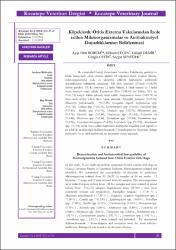Köpeklerde Otitis Externa Vakalarından İzole edilen Mikroorganizmalar ve Antibakteriyel Duyarlılıklarının Belirlenmesi
Özet
Bu çalışmada Uludağ Üniversitesi Veteriner Fakültesine getirilen ve klinik muayenede otitis externa şüpheli 54 köpekten kulak svapları alınmış, mikroorganizmalar izole ve identifiye edilerek bakterilerin antibiyotik duyarlılıklarını belirlemek amaçlandı. Elli dört örnekten 52’sinde (%96.29) üreme görüldü. Elli iki örnekten 12 farklı bakteri, 5 farklı mantar ve 2 farklı maya üremesi tespit edildi. Üremelerin 20’si (%38.46) saf kültür, 32’si ise (%61.53) karışık kültür şeklinde izole edildi. Staphylococcus aureus (%55.76) en fazla izole edilen etken iken, bunu sırasıyla Aspergillus fumigatus (%17.30), Malasseyia pachydermatitis (%17.30), Koagulaz negatif Staphylococcus spp. (%17.30), Candida spp. (%11.53), Epidermophyton spp. (%9.61), Penicillium spp. (%7.69), Bacillus spp. (%5.76), Citrobacter spp. (%5.76), Microsporum spp. (%5.76), Klebsiella spp. (%3.84), Streptococcus spp. (%3.84), Escherichia coli (%3.84), Micrococcus spp. (%3.84), Trichophyton spp. (%3.84), Pseudomonas spp. (%1.92), Corynebacterium pyogenes (%1.92), Enterobacter spp. (%1.92), Acinetobacter spp. (%1.92) izledi. İzole edilen bakterilere antibiyotik duyarlılık testi yapıldı ve en etkili iki antibiyotiğin Sulfamethoxazole/Trimethoprim ve Neomisin olduğu belirlendi. En az etkili antibiyotik ise rifampisin olarak saptandı. In this study, 54 ear swabs taken from suspected of otitis externa with dogs in Uludag University Faculty of Veterinary Medicine. Microorganisms isolated and identified. We determined the susceptibility of bacteriae to antibiotics. Microorganisms isolated from 52 (96.29 %) samples of 54 ear swabs. 12 bacteriae , 5 fungi, and 2 yeast isolated from 52 samples. The microorganisms were isolated in pure culture from (38.46 ) samples and were isolated in mixed culture from (%61.53) samples. Staphylococcus aureus (55.76% ) were most commonly isolated and respectively, Aspergillus fumigatus ( 17.30 % ), Malasseyia pachydermatitis ( 17.30 % ) , coagulase -negative Staphylococcus spp. ( 17.30 % ) , Candida spp. ( 11.53% ) , Epidermophyton spp. ( 9.61% ) , Penicillium spp . (7.69%) , Bacillus spp. (5.76% ) , Citrobacter spp. (5.76% ), Microsporum spp. (5.76% ) , Klebsiella spp. (3.84%) , Streptococcus spp. (3.84%) , Escherichia coli (3.84%) , Micrococcus spp. (3.84%) , Trichophyton spp. (3.84%) , Pseudomonas spp. ( 1.92 % ) , Corynebacterium pyogenes ( 1.92 % ) , Enterobacter spp. ( 1.92 % ) , Acinetobacter spp. ( 1.92 % ) were isolated and identified. We determined Sulfamethoxazole / Trimethoprim and neomycin were the most effective antibiotics. Rifampicin was found to be the least effective.
Kaynak
Kocatepe Veteriner DergisiCilt
7Sayı
1Bağlantı
http://hdl.handle.net/11630/2351Koleksiyonlar
- Cilt 7 : Sayı 1 [13]



















